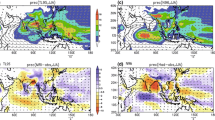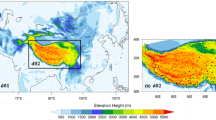Abstract
The precipitation over the Hengduan Mountains (HMs) during rainy seasons is investigated based on observations, reanalysis datasets, and 28 atmospheric general circulation models (AGCMs) from Coupled Model Intercomparison Project phase 5 (CMIP5). Most CMIP5 AGCMs generally capture two observed precipitation centers over the southwestern HMs and on the west side of Sichuan basin (WSSB), but their location, range, and magnitude vary with models. As the horizontal resolution increases, the details of simulated precipitation pattern are improved and closer to observation and reanalysis, as well as the increasing magnitude of precipitation over the southwestern HMs. However, the simulated precipitation on the WSSB is overestimated regardless of resolution. Mechanisms involved in resolution affecting precipitation pattern and biases of precipitation on the WSSB are explored. Representation of topography in AGCMs influences orographic effect, which contributes to simulations of both horizontal and vertical moisture flux convergence and further precipitation over the HMs. The biases of WSSB precipitation between reanalysis and AGCMs are attributed to the discrepancy in the vertical distribution of upward motions. The simulated upward motions can reach a higher level than reanalysis, and a spurious center of upward motions develops at 400 hPa due to the overestimation of circulation-precipitation feedback in AGCMs.









Similar content being viewed by others

References
Amante C, Eakins BW (2009) ETOPO1 1 Arc-Minute Global Relief Model: Procedures, Data Sources and Analysis. NOAA Technical Memorandum NESDIS NGDC-24, National Geophysical Data Center, NOAA, https://doi.org/10.7289/v5d798bf
Ashfaq M, Rastogi D, Mei R, Touma D, Ruby Leung L (2017) Sources of errors in the simulation of south Asian summer monsoon in the CMIP5 GCMs. Clim Dyn 49:193–223. https://doi.org/10.1007/s00382-016-3337-7
Barros AP, Lettenmaier DP (1993) Dynamic modeling of the spatial distribution of precipitation in remote mountainous areas. Mon Weather Rev 121:1195–1214. https://doi.org/10.1175/1520-0493(1993)121%3c2254:MCCIA%3e2.0.CO;2
Barros AP, Lettenmaier DP (1994) Dynamic modeling of orographically induced precipitation. Rev Geophys 32:265–284. https://doi.org/10.1029/94rg00625
Cannon F, Carvalho LMV, Jones C, Norris J, Bookhagen B, Kiladis GN (2017) Effects of topographic smoothing on the simulation of winter precipitation in High Mountain Asia. J Geophys Res Atmos 122:1456–1474. https://doi.org/10.1002/2016jd026038
Chen J, Bordoni S (2014) Orographic effects of the Tibetan plateau on the East Asian summer monsoon: an energetic perspective. J Clim 27:3052–3072. https://doi.org/10.1175/jcli-d-13-00479.1
Chen C-S, Huang J-M (1999) A numerical study of precipitation characteristics over Taiwan Island during the winter season. Meteorol Atmos Phys 70:167–183. https://doi.org/10.1007/s007030050032
Dai E, Wang Y, Ma L, Yin L, Wu Z (2018) ‘Urban-Rural’ gradient analysis of landscape changes around cities in mountainous regions: a case study of the Hengduan Mountain region in southwest China. Sustainability 10:1019
Dee DP et al (2011) The ERA-Interim reanalysis: configuration and performance of the data assimilation system. Q J R Meteorol Soc 137:553–597. https://doi.org/10.1002/qj.828
Dong W et al. (2016) Summer rainfall over the southwestern Tibetan Plateau controlled by deep convection over the Indian subcontinent. Nat Commun 7:10925. https://doi.org/10.1038/ncomms10925, https://www.nature.com/articles/ncomms10925#supplementary-information
Dong D, Huang G, Tao W, Wu R, Hu K, Li C (2018) Interannual variation of precipitation over the Hengduan Mountains during rainy season. Int J Climatol 38:2112–2125. https://doi.org/10.1002/joc.5321
Dong D, Tao W, Lau WKM, Li Z, Huang G, Wang P (2019) Interdecadal variation of precipitation over the Hengduan Mountains during rainy seasons. J Clim 32:3743–3760. https://doi.org/10.1175/jcli-d-18-0670.1
Duan A, Hu J, Xiao Z (2013) The Tibetan Plateau summer monsoon in the CMIP5 simulations. J Clim 26:7747–7766. https://doi.org/10.1175/jcli-d-12-00685.1
Fang S, Zhao Y, Han L, Ma C (2017) Analysis of landscape patterns of arid valleys in China, based on grain size effect. Sustainability 9:2263
Ferretti R, Low-Nam S, Rotunno R (2000) Numerical simulations of the Piedmont flood of 4–6 November 1994. Tellus A 52:162–180. https://doi.org/10.1034/j.1600-0870.2000.00992.x
Gelaro R et al (2017) The modern-era retrospective analysis for research and applications, Version 2 (MERRA-2). J Clim 30:5419–5454. https://doi.org/10.1175/jcli-d-16-0758.1
Goswami BN (1998) Interannual variations of Indian summer monsoon in a GCM: external conditions versus internal feedbacks. J Clim 11:501–522. https://doi.org/10.1175/1520-0442(1998)011%3c0501:ivoism%3e2.0.co;2
Harada Y et al (2016) The JRA-55 reanalysis: representation of atmospheric circulation and climate variability. J Meteorol Soc Jpn Ser II 94:269–302. https://doi.org/10.2151/jmsj.2016-015
Hertwig E, von Storch J-S, Handorf D, Dethloff K, Fast I, Krismer T (2015) Effect of horizontal resolution on ECHAM6-AMIP performance. Clim Dyn 45:185–211. https://doi.org/10.1007/s00382-014-2396-x
Hu K, Xie S-P, Huang G (2017) Orographically anchored El Niño Effect on summer rainfall in central China. J Clim 30:10037–10045. https://doi.org/10.1175/jcli-d-17-0312.1
Huang D-Q, Zhu J, Zhang Y-C, Huang A-N (2013) Uncertainties on the simulated summer precipitation over Eastern China from the CMIP5 models. J Geophys Res Atmos 118:9035–9047. https://doi.org/10.1002/jgrd.50695
Huffman GJ et al (2007) The TRMM multisatellite precipitation analysis (TMPA): quasi-Global, multiyear, combined-sensor precipitation estimates at fine scales. J Hydrometeorol 8:38–55. https://doi.org/10.1175/jhm560.1
Hughes M, Hall A, Fovell RG (2009) Blocking in areas of complex topography, and its influence on rainfall distribution. J Atmos Sci 66:508–518. https://doi.org/10.1175/2008jas2689.1
Hunt KMR, Turner AG (2017) The effect of horizontal resolution on Indian monsoon depressions in the Met Office NWP model. Q J R Meteorol Soc 143:1756–1771. https://doi.org/10.1002/qj.3030
Jiang Q (2003) Moist dynamics and orographic precipitation. Tellus A: Dyn Meteorol Oceanogr 55:301–316. https://doi.org/10.3402/tellusa.v55i4.14577
Jin Q, Yang X-Q, Sun X-G, Fang J-B (2013) East Asian summer monsoon circulation structure controlled by feedback of condensational heating. Clim Dyn 41:1885–1897. https://doi.org/10.1007/s00382-012-1620-9
Kang I-S et al (2002) Intercomparison of the climatological variations of Asian summer monsoon precipitation simulated by 10 GCMs. Clim Dyn 19:383–395. https://doi.org/10.1007/s00382-002-0245-9
Katzfey JJ (1995) Simulation of extreme New Zealand precipitation events. Part I: sensitivity to orography and resolution. Mon Weather Rev 123:737–754. https://doi.org/10.1175/1520-0493(1995)123%3c0737:soenzp%3e2.0.co;2
Kitoh A, Kusunoki S (2008) East Asian summer monsoon simulation by a 20-km mesh AGCM. Clim Dyn 31:389–401. https://doi.org/10.1007/s00382-007-0285-2
Kobayashi S et al (2015) The JRA-55 reanalysis: general specifications and basic characteristics. J Meteorol Soc Jpn Ser II 93:5–48. https://doi.org/10.2151/jmsj.2015-001
Kripalani RH, Oh JH, Kulkarni A, Sabade SS, Chaudhari HS (2007) South Asian summer monsoon precipitation variability: coupled climate model simulations and projections under IPCC AR4. Theor Appl Climatol 90:133–159. https://doi.org/10.1007/s00704-006-0282-0
Lau KM, Kim KM (2006) Observational relationships between aerosol and Asian monsoon rainfall, and circulation. Geophys Res Lett. https://doi.org/10.1029/2006gl027546
Lau KM, Kim MK, Kim KM (2006) Asian summer monsoon anomalies induced by aerosol direct forcing: the role of the Tibetan Plateau. Clim Dyn 26:855–864. https://doi.org/10.1007/s00382-006-0114-z
Li G, Xie S-P (2012) Origins of tropical-wide SST biases in CMIP multi-model ensembles. Geophys Res Lett 39:L22703. https://doi.org/10.1029/2012gl053777
Li G, Xie S-P (2014) Tropical biases in CMIP5 multimodel ensemble: the excessive equatorial Pacific cold tongue and double ITCZ problems. J Clim 27:1765–1780. https://doi.org/10.1175/jcli-d-13-00337.1
Li Z, He Y, Wang C, Wang X, Xin H, Zhang W, Cao W (2011) Spatial and temporal trends of temperature and precipitation during 1960–2008 at the Hengduan Mountains, China. Quatern Int 236:127–142. https://doi.org/10.1016/j.quaint.2010.05.017
Li G, Xie SP, He C, Chen Z (2017) Western Pacific emergent constraint lowers projected increase in Indian summer monsoon rainfall. Nat Clim Change 7:708. https://doi.org/10.1038/nclimate3387, https://www.nature.com/articles/nclimate3387#supplementary-information
López-Moreno JI, Goyette S, Beniston M (2008) Climate change prediction over complex areas: spatial variability of uncertainties and predictions over the Pyrenees from a set of regional climate models. Int J Climatol 28:1535–1550. https://doi.org/10.1002/joc.1645
Maloney ED, Chelton DB (2006) An assessment of the sea surface temperature influence on surface wind stress in numerical weather prediction and climate models. J Clim 19:2743–2762. https://doi.org/10.1175/jcli3728.1
Mishra SK, Anand A, Fasullo J, Bhagat S (2018) Importance of the resolution of surface topography in Indian monsoon simulation. J Clim 31:4879–4898. https://doi.org/10.1175/jcli-d-17-0324.1
Ogata T, Johnson SJ, Schiemann R, Demory M-E, Mizuta R, Yoshida K, Arakawa O (2017) The resolution sensitivity of the Asian summer monsoon and its inter-model comparison between MRI-AGCM and MetUM. Clim Dyn 49:3345–3361. https://doi.org/10.1007/s00382-016-3517-5
Prodhomme C, Batté L, Massonnet F, Davini P, Bellprat O, Guemas V, Doblas-Reyes FJ (2016) Benefits of increasing the model resolution for the seasonal forecast quality in EC-earth. J Clim 29:9141–9162. https://doi.org/10.1175/jcli-d-16-0117.1
Roe GH (2005) Orographic precipitation. Annu Rev Earth Planet Sci 33:645–671. https://doi.org/10.1146/annurev.earth.33.092203.122541
Saha S et al (2010) The NCEP climate forecast system reanalysis. Bull Am Meteorol Soc 91:1015–1058. https://doi.org/10.1175/2010bams3001.1
Saha S et al (2014) The NCEP climate forecast system version 2. J Clim 27:2185–2208. https://doi.org/10.1175/jcli-d-12-00823.1
Shang W, Ren X, Huang B, Cubasch U, Yang X-Q (2019) Subseasonal intensity variation of the South Asian high in relationship to diabatic heating: observation and CMIP5 models. Clim Dyn 52:2413–2430. https://doi.org/10.1007/s00382-018-4266-4
Smith RB (1979) The influence of mountains on the atmosphere. Adv Geophys B. Saltzman, ed, Elsevier, 87–230
Song Y, Qiao F, Song Z (2012) Improved simulation of the South Asian summer monsoon in a coupled GCM with a more realistic ocean mixed layer. J Atmos Sci 69:1681–1690. https://doi.org/10.1175/jas-d-11-0235.1
Sperber KR, Hameed S, Potter GL, Boyle JS (1994) Simulation of the Northern Summer Monsoon in the ECMWF model: sensitivity to horizontal resolution. Mon Weather Rev 122:2461–2481. https://doi.org/10.1175/1520-0493(1994)122%3c2461:sotnsm%3e2.0.co;2
Sperber KR et al (2013) The Asian summer monsoon: an intercomparison of CMIP5 vs. CMIP3 simulations of the late 20th century. Clim Dyn 41:2711–2744. https://doi.org/10.1007/s00382-012-1607-6
Tao W, Huang G, Wu R, Hu K, Wang P, Chen D (2017) Asymmetry in summertime atmospheric circulation anomalies over the northwest Pacific during decaying phase of El Niño and La Niña. Clim Dyn 49:2007–2023. https://doi.org/10.1007/s00382-016-3432-9
Tao W, Huang G, Wu R, Hu K, Wang P, Gong H (2018) Origins of biases in CMIP5 models simulating Northwest Pacific summertime atmospheric circulation anomalies during the decaying phase of ENSO. J Clim 31:5707–5729. https://doi.org/10.1175/jcli-d-17-0289.1
Taylor KE, Stouffer RJ, Meehl GA (2011) An overview of CMIP5 and the experiment design. Bull Amer Meteorol Soc 93:485–498. https://doi.org/10.1175/bams-d-11-00094.1
Ueda H, Ohba M, Xie S-P (2009) Important factors for the development of the Asian-Northwest Pacific summer monsoon. J Clim 22:649–669. https://doi.org/10.1175/2008jcli2341.1
Wang L, Huang G, Chen W, Zhou W, Wang W (2018) Wet-to-dry shift over Southwest China in 1994 tied to the warming of tropical warm pool. Clim Dyn 51:3111–3123. https://doi.org/10.1007/s00382-018-4068-8
Xu Y, Gao X, Shen Y, Xu C, Shi Y, Giorgi F (2009) A daily temperature dataset over China and its application in validating a RCM simulation. Adv Atmos Sci 26:763–772. https://doi.org/10.1007/s00376-009-9029-z
Yao J, Zhou T, Guo Z, Chen X, Zou L, Sun Y (2017) Improved performance of high-resolution atmospheric models in simulating the East Asian summer monsoon rain belt. J Clim 30:8825–8840. https://doi.org/10.1175/jcli-d-16-0372.1
You Q, Min J, Zhang W, Pepin N, Kang S (2015) Comparison of multiple datasets with gridded precipitation observations over the Tibetan Plateau. Clim Dyn 45:791–806. https://doi.org/10.1007/s00382-014-2310-6
Zhang K, Pan S, Cao L, Wang Y, Zhao Y, Zhang W (2014) Spatial distribution and temporal trends in precipitation extremes over the Hengduan Mountains region, China, from 1961 to 2012. Quat Int 349:346–356. https://doi.org/10.1016/j.quaint.2014.04.050
Zhou T, Li Z (2002) Simulation of the east asian summer monsoon using a variable resolution atmospheric GCM. Clim Dyn 19:167–180. https://doi.org/10.1007/s00382-001-0214-8
Acknowledgements
We acknowledge the World Climate Research Program’s Working Group on Coupled Modeling, which is responsible for CMIP, and we thank the climate modeling groups (listed in Table 1 of this paper) for producing and making available their model output. For CMIP, the U.S. Department of Energy’s Program for Climate Model Diagnosis and Intercomparison provides coordinating support and led development of software infrastructure in partnership with the Global Organization for Earth System Science Portals. We thank two anonymous reviewers as well as the editor for their useful comments. This work was supported by the Strategic Priority Research Program of Chinese Academy of Sciences (XDA20060501), the National Key R&D Program of China (2018YFA0605904), the National Natural Science Foundation of China (41705068, 41831175, 41425019, and 41721004), the China Postdoctoral Science Foundation (2016LH0005 and 2016M600116), the scholarship from China Scholarships Council under the State Scholarship Fund (201704910055), and the Natural Science Foundation of Guangdong Province (2016A030310009).
Author information
Authors and Affiliations
Corresponding author
Additional information
Publisher's Note
Springer Nature remains neutral with regard to jurisdictional claims in published maps and institutional affiliations.
Electronic supplementary material
Below is the link to the electronic supplementary material.
Rights and permissions
About this article
Cite this article
Tao, W., Huang, G., Lau, W.K.M. et al. How can CMIP5 AGCMs’ resolution influence precipitation in mountain areas: the Hengduan Mountains?. Clim Dyn 54, 159–172 (2020). https://doi.org/10.1007/s00382-019-04993-w
Received:
Accepted:
Published:
Issue Date:
DOI: https://doi.org/10.1007/s00382-019-04993-w



